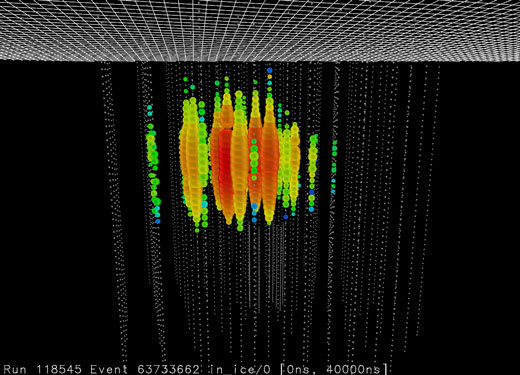
From its vantage point at the geographic South Pole in Antarctica, the IceCube Neutrino Observatory is uniquely positioned to see neutrinos—mysterious, nearly massless, difficult-to-detect particles that are plentiful but little understood.
IceCube, as the neutrino observatory is affectionately known, records neutrino interactions from atmospheric and astrophysical sources. Atmospheric neutrinos are produced during particle interactions at the edges of the Earth’s atmosphere. Astrophysical neutrinos are produced in the great particle accelerators of the universe, such as supernovas. Cosmogenic neutrinos are a type of astrophysical neutrino that, according to models, should point back to the highest energy cosmic rays.
“The cosmic accelerators of high-energy cosmic rays are one of the oldest unsolved mysteries,” explains Francis Halzen, IceCube principal investigator and University of Wisconsin-Madison physics professor. Indeed, an IceCube publication in the journal Nature made the news last year when data showed that there was an unexpected absence of neutrinos associated with observed gamma-ray bursts, one of the leading candidate sources for the origin of the highest energy cosmic rays.
Astrophysics is riddled with mysteries; like neutrinos themselves, little is known about the forces that create them.
Up until recently, IceCube has mostly reported on atmospheric neutrinos created in particle showers known as cosmic rays. While these observations have yielded interesting discoveries, the main focus is still on the search for neutrino sources outside our atmosphere.
In a dedicated search for cosmogenic neutrinos, IceCube collaborator Aya Ishihara at Chiba University in Japan found two “events” in data taken with the full, 86-string detector. In IceCube terms, an event is a particle interaction in or near the detector. Using data from IceCube, physicists reconstruct the path of particles as they travel through the South Pole ice, with visual cues providing information about energy level and direction.
The two events, nicknamed Bert and Ernie, were identified as having energies in the PeV range. PeV refers to the energy level in electron volts, or eV, a common unit of energy within physics. Electron volts use metric prefixes, with PeV representing a peta-electron volt, considered a high-energy neutrino event.
Ishihara’s events both began inside the detector and appear to have been initiated by electron or tau neutrinos. They contained showers more than 500 meters in length. Overall, IceCube occupies a cubic kilometer of ice.
Analysis to determine the directions of the two neutrino events and to narrow in on the energy range of each is ongoing, but regardless, they are intensely interesting. A dedicated search has been initiated to find similar, high-energy events. With the expected discovery of more such events, some should contain tracks that will point back to the source of the neutrino with greater clarity.
Either way, these events represent an interesting hint for new neutrino physics and astrophysics.